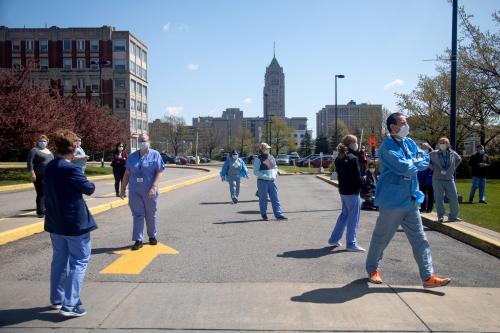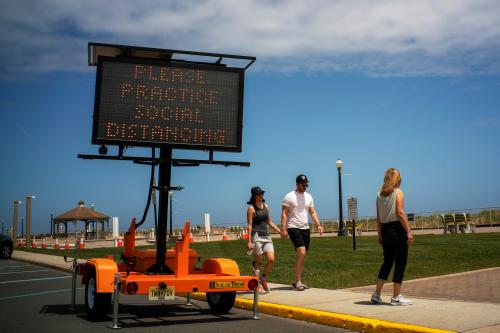More than 40 states have announced plans to relax social distancing restrictions, and by the end of this week, all 50 states will be reopening parts of their economies to some degree. However, one of the biggest challenges in designing a policy response to the COVID-19 pandemic and structuring work incentives appropriately is that what might seem like a purely person choice – whether to return to work and take the risk of acquiring COVID-19 or not – has an enormous impact on the rest of the public. A key question is how do we construct a policy that allows the loosening of uniform government restrictions and some degree of individual choice while, at the same time, getting the right number of people – and the right people – to stay at home from the perspective of the greatest social good?
It should first be made clear that the current benefits to social distancing are still so large in monetary terms that we are not at a point where tradeoffs in terms of lost economic activity are very meaningful in comparison to the magnitude of the mortality benefits alone. Indeed, many economists have argued that the assumed tradeoff between suppression of the virus and the health of the economy is, in fact, illusory. However, as medical and technological advances are made, and as the availability of testing and contact tracing increases, we may eventually get to a point where these tradeoffs start to matter. Looking toward the future, if we want to eventually have a loosening of uniform government restrictions and allow individuals to have a choice regarding whether to work or to stay at home, a key challenge is in determining how to construct a policy that provides appropriate incentives to encourage the right number of people to work, from a social perspective, without having a resurgence of the virus.
A social versus private benefit to staying at home
Some have argued that government involvement is unnecessary and that simply providing information for individuals to choose whether to continue practicing social distancing or not is a sufficient role for government. However, the fact still remains that for the individual worker, social distancing requires undertaking something extremely costly – to stay at home – which, for the vast majority of workers in the US, means giving up their earned income. At the same time, the majority of the benefit accrues to society at large. This problem is exacerbated by the fact that the costs of social distancing are extremely unequal, and such costs of serving the public interest by social distancing are greatest for the lowest wage workers.1
The key issue is that there is a large discrepancy between the benefit that accrues to the individual and the benefit that accrues to the public, while all of the cost is borne by the individual. People primarily make the decision to stay at home based on the costs and benefits to themselves, rather than to society as a whole. Of course, people who stay at home do benefit – they are less likely to contract the virus themselves and become sick. However, they are less likely to take into account the social benefit – that there will be a far lower rate of transmission of the virus to others as a result of their staying at home. Such social costs and benefits – modern economists call them “externalities” – don’t often enter the calculations of individuals; individuals often don’t consider the risk that they pose to others as a result of perhaps willingly taking on the risk for themselves.2 While the innate desire to help one another should not be underestimated, the crucial point is that as government mandates are loosened, even though some people will still voluntarily stay at home, the number of people who will choose to not to go out is still lower than the number of people who should choose not to when we take into account the interest of the public – which, in this case, is overwhelmingly larger than the interest of the individual in the same action.
Large externalities are a classic example of a market failure, but in the case of the COVID-19 pandemic, the difference between the individual incentive to stay home and the social benefit is enormous. The majority of the benefit of an individual staying at home actually accrues to society at large – more than 99.9 percent – while less than 0.1 percent of the benefit of the individual action goes to the individual.3 Simply put – I, as an individual, would relish the opportunity to keep my income and continue to work and, instead, pay everyone else to stay at home. Others would like to do the same. The amount that we would like to pay, collectively, would actually be more than enough to convince a large fraction of people to stay at home. The only problem is that we need someone to coordinate these payments.
Re-examining the role of government
This is where the government plays an important role. While it is infeasible for individuals to coordinate paying each other to stay home, the government can easily do so. In fact, there is a history of the government using taxes to align individual incentives with social welfare, for instance, in the case of a cigarette tax to address the costs that smoking cigarettes imposes on others or the concept of a carbon tax to address the externality of global warming. Economists on both ends of the political spectrum have long championed such an approach – known as a “Pigouvian tax” – because on one hand, it keeps decision-making with the individual, which is ideal when people face different costs to social distancing: if they’re doing it voluntarily, they’re probably the people who can do it at least cost. On the other hand, by providing a tax or a subsidy to the individual, it allows that individual to take into account the full social cost or benefit of their actions.
So how would this work in the case of COVID-19? We could easily construct a benefit – specifically an unemployment insurance benefit – that would be based on the cost to the rest of society of an additional person being at work for 40 hours per week instead of spending the same amount of time at home, in terms of lives lost and health costs incurred. An individual would then face the decision of whether to go to work and give up the benefit or stay at home and continue to receive the benefit. If someone voluntarily turns down the benefit in order to work, this approach ensures that it must also be the case that what they are producing by working generates greater value to society at large than the additional risk they impose on others by working outside of the home.
An important advantage of this approach is that it allows us to tailor the incentives to stay at home to the value to society of the work that an individual does. We don’t necessarily want, from a social welfare perspective, the number of people who work outside of the home to be zero. Some activities and jobs, especially when they enable people to receive food, healthcare, medicine, or simply enable the majority of people to be able to stay at home (while still enjoying the benefits of an industrialized society), may be especially valuable, and such work may outweigh the cost to society of their being out and about.
The extent to which this proposal accomplishes its intended effects – getting the right number of people to work, and specifically those workers whose work is most valuable to society – depends on whether the wages that workers receive are in line with the value of the work provided to society. A critical part of this proposal is, therefore, that all workers have a choice between accepting a job and accepting unemployment benefits.4 While this would likely result in employers needing to pay essential workers higher wages in order to incentivize them to work, this proposal would likely generate the much-needed positive side effect of getting essential workers increased pay, and quickly, to help compensate them for the increased risk that they face. It would also put upward pressure on wages to mitigate some of the large difference between the wages paid to a substantial fraction of essential workers and the value that the work provides to society. Whether this will occur is an empirical question, but several states have already allowed vulnerable workers to turn down jobs and still receive unemployment benefits. These states will provide a good testing ground with which to answer this question.
Structuring unemployment benefits on the basis of the value to society of staying home rather than the cost to the individual offers two additional advantages:
- It allows us to calculate precisely how to phase out unemployment benefits as we move through the arc of the pandemic and an additional hour outside of the home eventually becomes less costly to others. The cost of being outside will depend critically on the availability and uptake of testing and contact tracing, as well as how testing is implemented.
- This proposal allows for a recovery plan that need not be a “one-size-fits-all” plan for the entire country. This structure allows the “incentive to return to work” to be tailored to different regions of the country, where the costs of not social distancing may vary depending on the density of the population, demographic vulnerability, the capacity of local health and social service infrastructures, the fraction of people who are required work in close proximity to others, and the fraction of the population living in group facilities, among other risk factors.
So what, exactly, does the value-based approach to determining the incentive to stay-at-home yield? A back-of-the-envelope calculation, based on a set of recent studies, including research by Michael Greenstone and Vishan Nigam and building on Ferguson et al. (2020), suggests that the current social benefit to an individual staying at home is roughly $1500 per week.5 While $1500 per week is a large amount of money to distribute through the unemployment benefits system, it is worth noting that the magnitude of the number reflects the sheer size of the benefit to the public of social distancing. Greenstone and Nigam, for example, find that the mortality benefits of social distancing are currently approximately $8 trillion for three to four months of moderate social distancing – or, to make it a bit more concrete, approximately $60,000 per US household over that period. It is hard to imagine any other activity that would generate such large economic value per household in such a short period of time. What that magnitude means is that right now, for the vast majority of workers in a large fraction of occupations, the most productive activity they can do, in terms of the total value generated for the American people, is to stay at home.6
Pandemic economics: Turning traditional work incentives on their head
Some have expressed concern that policies such as enhanced unemployment insurance create a “disincentive to work,” especially as we begin to think about a pathway out of the pandemic and returning to work. However, being in a pandemic turns traditional work incentives on their head. It is in the public’s interest to attach pay specifically to the behavior that has the greatest contribution to social welfare. The magnitude of the estimate demonstrates that current concerns about too large a “disincentive to work,” even in states with the most generous unemployment benefits, are not justified. A policy that offers additional cash incentives to return to work, beyond the income that an individual already earns, creates incentives that run precisely in the opposite direction as those that are needed and will cause more harm to the public than good. Under this proposal, any encouragement or discouragement from returning to work is by design. In other words, paying a large fraction of people not to work is not so strange of an idea when viewed as paying people to engage in the activity that has the greatest value to society.
Of course, $1500 per week is just a starting point, based on the current situation. This framework allows us to conceive of what a reasonable pathway out of the pandemic would look like: as medical and technological progress is made, and the availability and uptake of testing improves, the cost to society of working outside of the home will decline, and unemployment benefits can be phased out according to the declining social cost. Moreover, it is important to remember that the actual amount paid will differ across regions of the country. In regions of the country where the social cost of working outside of the home is lower, unemployment benefits can also be lower, allowing for greater variation in both the timing and the rate at which the movement towards normalcy resumes across different regions in the country.
We are currently seeing the tension between individual incentives and the public good emerge as protestors to stay-at-home orders are taking to the streets. The tension arises in large part because government mandates are asking individuals to do something that is personally costly and that, at its core, is actually not for themselves, but for others. Thus far, the way the expansion of unemployment benefits has been viewed is as a way to help people endure the “fallout” of staying at home. However, we can do better. We can construct an unemployment benefit that would allow individuals to internalize the benefit that their actions offer the rest of society as well. This would allow us to achieve as a society an outcome that is difficult to achieve through individual action alone.
-
Footnotes
- As new research by Simon Mongey and Alex Weinberg shows, workers in low-work-from-home or high-physical-proximity jobs are more economically vulnerable across various measures: they are less likely to be white, less likely to have a college degree or employer-provided healthcare, more likely to rent their homes, have fewer liquid assets relative to income, and are more likely to be in the bottom half of the income distribution.
- Research from social psychology is consistent with this idea.
- Using recent estimates of the average doubling rate of the virus, an individual being infected today would result in 4096 infected individuals within four months. This means that any action that reduces the likelihood of an individual being infected with the virus results in roughly 1/4097 of the benefit accruing to the individual, while 4096/4097, or more than 99.9% of the benefit, accrues to others. This may be an underestimate of the share of the benefit of social distancing that goes to the public – these estimates were calculated after social distancing measures had already been put in place and the growth rate of infections had slowed. Using estimates that the baseline reproduction number (R0) related to COVID-19 is in the range of 2.0-2.5, estimates that the median number of days for which a person is infectious is 9.5, estimates that the median incubation period is five days, and results of studies showing that presymptomatic transmission can occur for one to three days before symptom onset generates a similar proportion of the social benefit relative to the individual benefit: between 99.7% and 99.9% of the benefit goes to the public.
- Though states generally do not allow residents to receive unemployment insurance if they turn down a job offer that matches their skill set and work history, some states are issuing orders to allow vulnerable workers to turn down a job and receive unemployment benefits, and there is an ongoing debate in several state labor departments about whether workers can turn down job offers and continue to receive unemployment benefits.
- This estimate comes from the average benefit per individual of implementing a social distancing policy for four months relative to no social distancing, as in Greenstone and Vishan (2020). Note that because there are no studies that yield the entire marginal benefit curve, the calculation of this estimate is actually based on average benefit, rather than a marginal benefit. This means that the marginal benefit of staying at home can be much lower when everyone is social distancing (the first person to come outside when everyone else is at home has a lower impact on society), but also that the marginal benefit can be much greater when no one is social distancing (when very few people are social distancing, each person who stays at home will reduce transmission of the virus to a much larger extent). To estimate this benefit precisely, further research would be needed to determine the benefit of social distancing at intermediate values of participation in social distancing.
- This estimate of the economic benefits is underestimated for a few reasons: it does not account for the value of reducing non-fatal sicknesses associated with COVID-19, the study uses a minimal form of social distancing to form its estimates, and the value of a statistical life used in this paper comes from small changes in the probability of death and what individuals are willing to pay to avoid those increases, whereas in this context, we are dealing with large changes in mortality rates.






